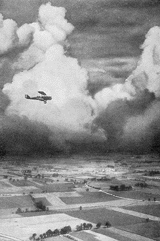beauty: the seeing eyeslow-motion pictures
Just a casual trip from New York to Washington. I could sit quite still and let the roar of the engine cover me like music. The vibration hummed in the soles of my feet, and was satisfying as a hearth fire or rain on the roof. Contented, I could look down at that calm clear world below.somewhere, over the rainbow
A new world too, it was, for I had not flown in many months and the objects below me wore the freshly painted vividness of things seen for the first time. They passed, bright and irrelevant images, slowly under the still suspended wheel of our plane. The images that attracted me were unrelated and scattered, not strung along one thread by a road. (The pencil-marked shadows of telegraph poles. The neatly combed fields. Docks and piers and bridges, flat slabs laid on the edge of a mirror. Cities, sudden flashes from an apartment window or a moving car, like a bright speck of glass in a road, sparkling far beyond its worth. How slowly those little cars crawl along the narrow ribbon paths!)
And looking down on those little houses, those little paths, the narrow lines of black beetles, the anthill traffic of cars, one sat back and wondered, 'Why? What do we do this for? Why isn't life simple and still and quiet? Was I really there yesterday? What was I doing?'
One could sit still and look at life from the air; that was it. And I was conscious again of the fundamental magic of flying, a miracle that has nothing to do with any of its practical purposes - speed, accessibility, and convenience - and will not change as they change. Looking down from the air that morning, I felt that stillness rested like a light over the earth. What motion there was took on a slow grace, like slow-motion pictures which catch the moment of outstretched beauty that one cannot see in life itself, so swiftly does it move.
And if flying, like a glass-bottomed bucket, can give you that vision, that seeing eye, which peers down to the still world below the choppy waves - it will always remain magic.Anne Morrow Lindbergh, North to the orient (1935)
beauty
I was utterly alone in the sky, yet suddenly, against the wall of the cloud, I saw another machine. It was so close that instinctively I yanked the stick and reeled away, my heart in my mouth. A second later, I looked round and laughed - there was nothing there! It was my own shadow I had seen, the silhouette of the Parasol on the white cheek of the cloud. I came back to observe this strange and rare phenomenon. There on the cloud was my shadow, dark, clean-cut; but more than the shadow, for around it was a bright halo of light, and outside that a perfect circular rainbow, and outside that again another rainbow, fainter, reversed.
I shut off, turned east, and came down. The white floor, several thousand feet below, rose up towards me, turned at last from a pavement of pearl to just a plain bank of fog. I plunged into it. I might be going back from paradise to purgatory, so grey and cold and comfortless it was. And as I sank through it, listening to the singing of the wires, I was thinking how some day men might no longer hug the earth, but dwell in heaven, draw power and sustenance from the skies, whirl at their will among the stars, and only seek the ground as men go down to the dark mysteries of the sea-floor, glad to return, sun-worshippers, up to the stainless heaven.
The melancholy landscape of stubble fields and bare trees appeared. I picked up a road, got my bearings, and swept off home at a hundred feet. 'Did you see anything?' said another pilot, strolling up to the machine. 'Nothing. It's completely dud.'Cecil Lewis, Sagittarius rising (1936)
beauty
Your comments or suggestions are greatly appreciated: e-mail Hanneke Hoogstrate!
or, for the JavaScript-disabled: blagoAntiRobot@xs4all.nl, please remember to remove [AntiRobot].This page is from Plane Writing: quotes from early pilots' biographies; please use a JavaScript-enabled browser for best results.